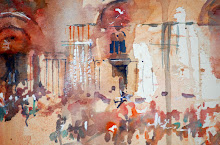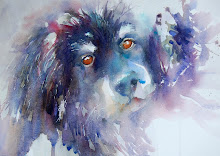"Peacock Study in Watercolour"
Demonstration from this weeks UK workshops
Its' amazing how many artists come to my workshops wishing to loosen up in technique and yet are reluctant to put down their pencil. I do understand. If you are used to using a preliminary sketch before painting coming on one of my courses can be daunting. I never use a pencil to make marks on my watercolour paper before I create. For one reason, I find the actual lead of the pencil can effect my colours no matter how lightly I use the pencil and this can damage my fresh results. But I also find pencil marks definitely restrict my creativity. Once in place my brain won't allow me to place colour where I want it to be. I find I have to add colour exactly where the pencil marks are telling me to and this limits my journey in exploration of a subject. I learn about each new subject by placing colour shapes where I see them, from by observing the real thing. Or from a resource photograph if needed in a workshop.
This weeks workshops saw a fabulous group of artists each day arriving to set up eagerly to paint. One of the returning artists is now a person I regard as a friend rather than someone who turns up at my courses. They have the most wonderful personality and they always without fail bring with them not only resource photos that they use but they are so generous in spirit that if anyone in the room is lost at any time on what to paint, or if they prefer what she has, she will offer to share her images which is really kind. This happened this week with an image of a peacock.
( Thank you Penny! )
After my morning demonstrations I wandered around offering "one on one" tuition and help to each artist in the room. As I approached one table at the back of the room I noticed a preliminary pencil sketch of a peacock on their easel. It was lovely. beautifully drawn. The artist explained to me that as much as they wanted to they couldn't paint without initial pencil lines to guide them. There is absolutely no problem with this at all. Its a beautiful style that suits many well known and famous artists. It just isn't the way I work. As the artist wanted to paint without sketching I brought them to my own painting area and gave the above "one on one" demonstration as tution to help them overcome their personal obstacle of their having to use pre sketching techniques.
I advised they just painted the head of the subject at first. In this case it was a peacock. I showed how simple painting without skettch can be. Starting with the eye at first but taking time to get this starting point right. I loved how the artist explained to me how surprised they were at the length of time and care I took over this one starting point. They had imagined all " loose" work was painted quite quickly. Actually it isn't. For example. If the eye isn't right at the start of my bird or animal paintings there is no point in my working further. So at the starting stages of a subject painting like this I seriously take my time. I think carefully on where to place the starting marks on my paper. I imagine where the surrounding body or head will go too. I do take my time and I enjoy thinking about how the painting will grow.
I explained that if you are an artist who likes using a pencil, think of your rigger brush as your painting tool to replace it. Make fine watercolour lines to begin. Or even paint with water alone to see if the shape or placement you are making is correct before adding colour to the water marks first made.
Paint little sections of subjects rather than a whole animal or bird until you train your eye and hand to paint what you see minus a preliminary sketch. In time you won't need that pencil and you will learn to observe colour and shape really well.
But until you try you will never get to a point where letting go of your penicl will happen.
Practise make sperfect.
So practise. And don't be afraid to let that pencil go!
************
Artists Tips
1) Paint small sections of a subject to train your eye and hand, to improve your painting skills
2) Paint new subjects so that you have to think about what goes where when creating.
3) Lose the pencil. You will only learn to work without it by not having it around!
4) If you want to paint in a new style, practise and practise some more. Regular practise does make you a much better artist!
5) Don't be hard on yourself ! If something goes wrong learn from each mistake and grow from it.
***************
Happy painting!
1) Paint small sections of a subject to train your eye and hand, to improve your painting skills
2) Paint new subjects so that you have to think about what goes where when creating.
3) Lose the pencil. You will only learn to work without it by not having it around!
4) If you want to paint in a new style, practise and practise some more. Regular practise does make you a much better artist!
5) Don't be hard on yourself ! If something goes wrong learn from each mistake and grow from it.
***************
Happy painting!


























1 comment:
Lovely helpful words which I will try AGAIN to put into practice - you never fail to inspire and encourage and for that I sincerely thank you :)
Post a Comment